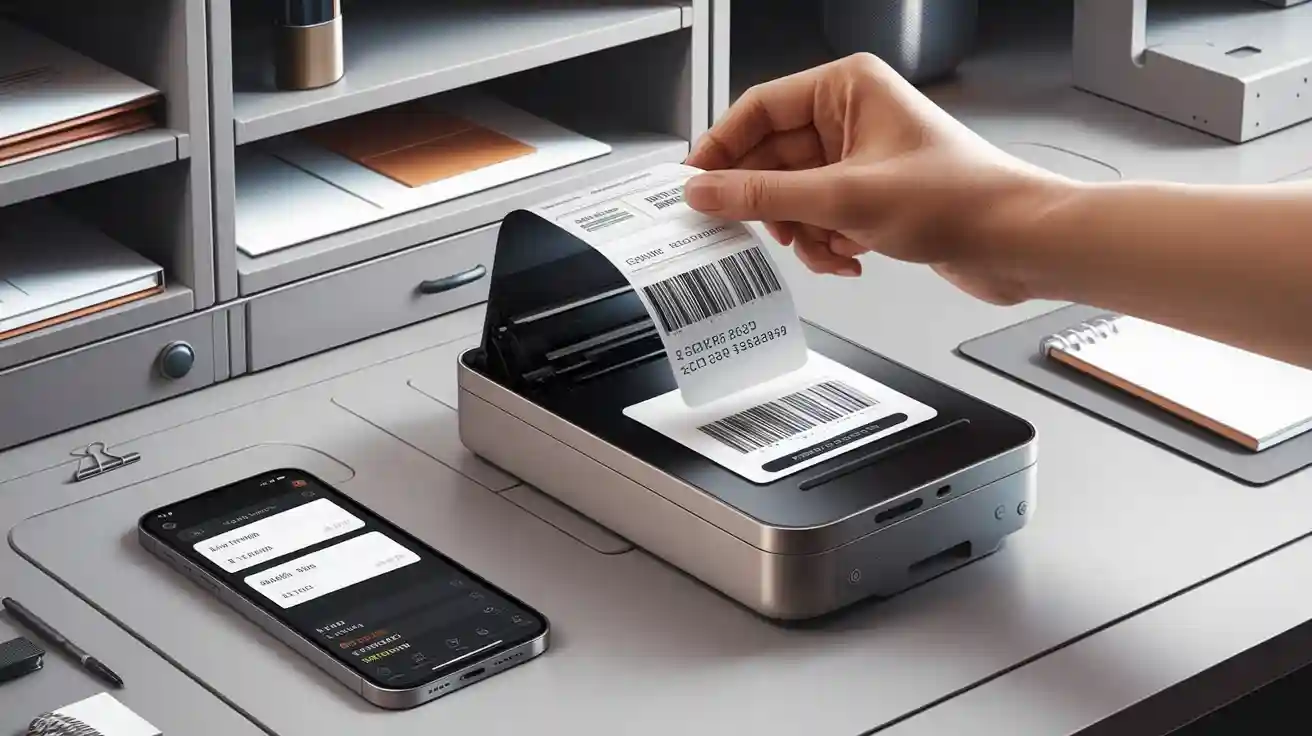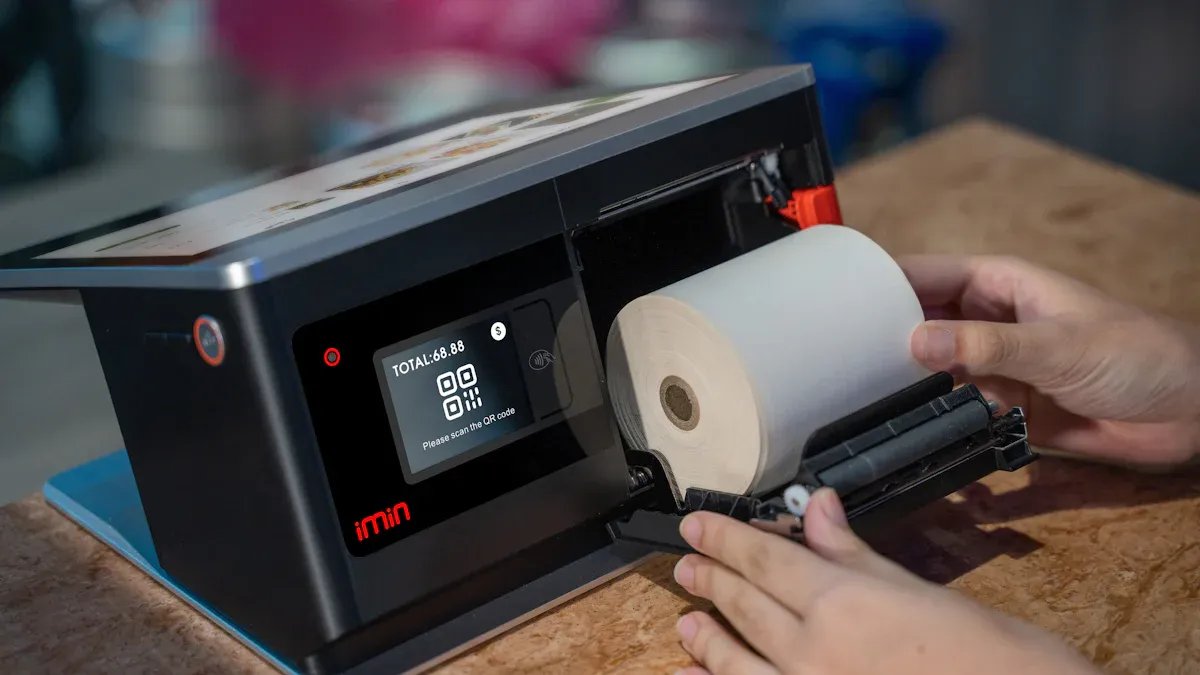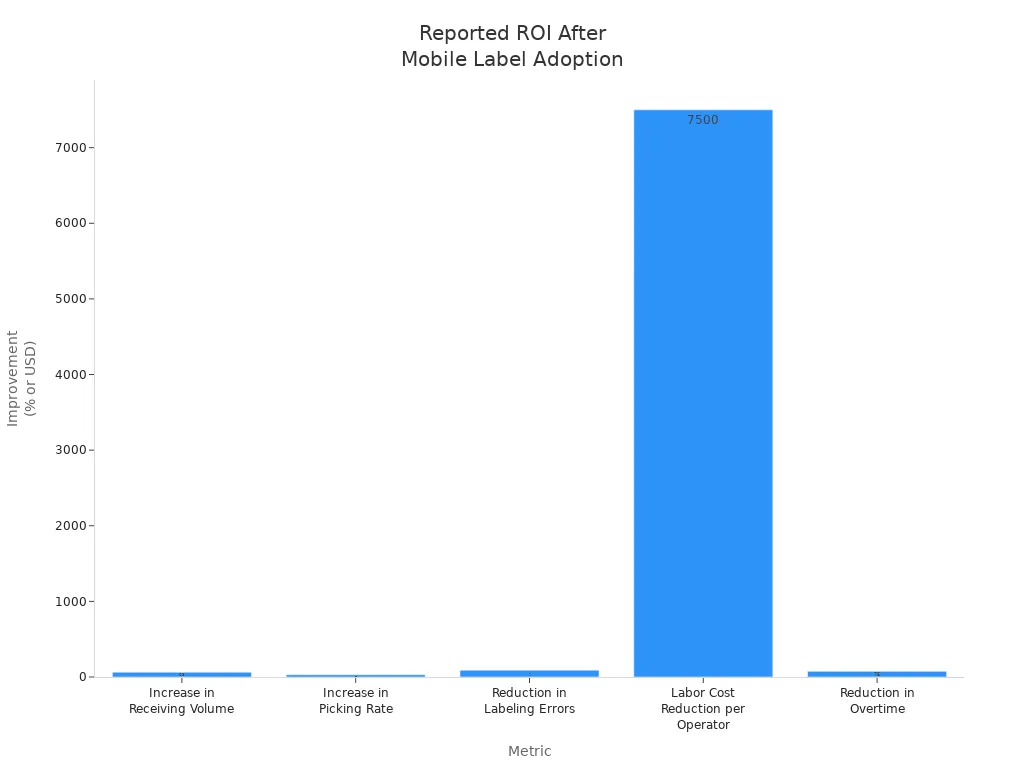
Mobile printer labels are special labels made to work with a mobile label printer. They help people print labels anywhere they need them. These labels let users finish printing jobs right away. You can use them in a warehouse, on a building site, or while making a delivery. A mobile printer gives businesses more choices and makes things easier. It is helpful for companies that need to print while moving around. The main businesses using mobile printers are retail, logistics, manufacturing, and healthcare.
Industry/Sector | Primary Use Cases |
|---|---|
Price tags, product labels | |
Warehouses | Inventory management, floor marking |
Logistics Companies | Shipping labels, fast package handling |
Construction Sites | Safety labeling, pipe marking, emergency signage |
Mobile printers help businesses work better. They make it easy to print almost anywhere.
Key Takeaways
Mobile printer labels let you print labels anywhere. This helps workers finish jobs faster. It also helps them make fewer mistakes. These labels use special materials and adhesives. This helps them stay clear and stick well. They work even in tough places like outside or in warehouses. Direct thermal printing is simple and saves money for short-term labels. Thermal transfer printing makes labels that last a long time. These labels are strong and durable. Mobile printers connect wirelessly to phones and tablets. This makes printing easy when you are moving. It also helps people work better. Picking the right printer, label size, and adhesive is important. You should choose based on your work environment. This makes sure labels stay easy to read and work well.
Mobile Printer Labels

Definition
Mobile printer labels are made to work with a mobile label printer. These labels let people print what they need, right where they are. You can use them in a warehouse, a truck, or on a building site. The labels come in rolls or sheets that fit small printers. Each label is simple to load and use, even when you are moving.
Mobile printer labels must match the mobile label printer’s technology. Most mobile printers use direct thermal or thermal transfer printing. So, the labels need the right surface and material for clear prints. The labels often show barcodes, addresses, or product details. They help workers track items, mark packages, or share information fast.
Key Features
Mobile printer labels have special features that make them different. They are not like the labels used in big, stationary printers.
Note: Mobile printer labels are easy to carry, quick to use, and can be used in many places. They help people label things right away, even in hard conditions.
Common Materials
Material Type | Examples | Notes |
|---|---|---|
Direct Thermal Paper | Premium Paper, Economy Paper | Used for direct thermal printing |
BOPP Film | Direct Thermal BOPP Film, Thermal Transfer BOPP Film | Weatherproof and durable |
Inkjet Paper and Films | Inkjet Premium Paper, Inkjet Weatherproof BOPP Films | Less common in mobile printers |
Adhesive Types | Ultra Removable, Removable, Permanent | Important for easy application and removal |
Mobile printer labels use materials like direct thermal paper and BOPP film. These materials help the labels stand up to water, tearing, and rough use. Some labels have special adhesives, so they stick well or come off easily. This makes them good for many jobs, like shipping or inventory.
Distinguishing Features
Feature | Mobile Printer Labels | Traditional Industrial Labels |
|---|---|---|
Portability | Highly portable, for on-the-go use | Stationary, for fixed locations |
Core Size | Smaller cores (0.75″ to 1″) | Larger cores (1″ to 3″) |
Roll Diameter | Smaller rolls (≤ 2.5″) | Larger rolls (up to 8″) |
Printing Tech | Direct thermal, no ink or ribbons | Often needs ribbons or ink |
Label Width | 2″ to 4″ wide | Wider, for high-volume printing |
Adhesive Options | Permanent, removable, freezer-grade | Mostly permanent adhesives |
Material Types | Thermal paper, BOPP films | Durable, for long-term use |
Use Cases | Real-time, field, logistics, retail | High-volume, long-term warehousing |
Cost Efficiency | Needs ribbons/ink, higher costs | |
Connectivity | Bluetooth/Wi-Fi compatible | Usually wired, stationary printers |
Mobile printer labels are smaller and lighter than regular labels. They fit into mobile label printers with small rolls and cores. The labels use direct thermal printing, so they do not need ink or ribbons. This saves money and makes printing faster. The labels come in different widths and adhesive types, so users can choose what works best.
Durability and Legibility
Many mobile printer labels use strong materials like polyester, polypropylene, or vinyl. These materials keep the labels safe from water, chemicals, and rough use.
Some labels have extra coatings, like laminates or varnishes, to stop fading and scratches.
Thermal transfer printing makes prints last longer and stops smudging, which is good for tough places.
High-resolution printing keeps text and barcodes clear and easy to read.
Mobile label printer brands like Zebra, Brother RuggedJET, and Honeywell make their printers for hard jobs. These printers work with special label materials and printing styles to keep labels strong and easy to read.
Additional Features
Mobile printer labels often work with barcode and RFID printing. This helps with tracking and inventory.
Wireless features, like Bluetooth or Wi-Fi, let people print labels from phones or tablets.
Built-in batteries in mobile label printers let people print without plugging in, so they are great for fieldwork.
Tip: Picking the right label material and adhesive helps labels stay put and easy to read, even in tough places.
Mobile Label Printer Technology
Direct Thermal Printing
Direct thermal printing uses heat to make images on special label material. The printhead gets hot and touches the label. The heat makes the treated paper turn dark in certain spots. This way does not need ink, toner, or ribbons.
Advantages of Direct Thermal Printing:
It costs less to use than inkjet or laser printers.
You do not need ribbons, ink, or toner.
It is simple to use and easy to load labels.
It works well for short jobs and is reliable.
It is better for the environment because there is no ribbon waste.
There is little maintenance since there are fewer moving parts.
Disadvantages of Direct Thermal Printing:
Images can fade over time, especially with heat or sunlight.
Labels may turn dark or hard to read if they get too hot.
The label can get marked if it is rubbed or scratched.
There are not many label material choices.
It only prints in black.
The printhead wears out faster and needs to be replaced more often.
It is not good for long-term or high-contact labeling.
Typical Use Cases:
Shipping labels and distribution tags
Inventory management and identification
Receipts, coupons, and event tickets
Parking tickets, citations, and visitor passes
Any short-term label printing where speed and convenience matter
Tip: Direct thermal mobile printers are best for quick jobs. They help workers print labels and receipts right where they need them.
Thermal Transfer Printing
Thermal transfer printing uses heat to move ink from a ribbon onto the label. The printhead heats the ribbon, and the ink sticks to the label. This makes sharp, long-lasting images that do not smudge and can handle water and chemicals.
Key Features of Thermal Transfer Printing:
It makes prints that last and do not smudge.
It works with many label materials, even synthetic films.
It can print in colors besides black.
Prints stay readable in tough places.
Advantages:
It gives high print quality with sharp text and barcodes.
Labels can handle heat, water, and chemicals.
It is good for long-term and outdoor use.
It works with many types of label materials.
Disadvantages:
It needs ribbons, which cost more and make waste.
It is harder to load and keep up than direct thermal printers.
The printer and supplies cost a bit more at first.
Typical Use Cases:
Thermal transfer mobile printers help people print labels that must last. These printers work well in tough places with water, chemicals, or sunlight. Common uses include:
Product labeling and asset tagging
Laboratory sample labels and patient wristbands
Outdoor signage and equipment labels
Inventory management in warehouses and factories
Field service operations and proof of delivery
Typical Use Cases | Key Features Supporting Use Case | |
|---|---|---|
Transportation & Logistics | Shipping, inventory, proof of delivery | Portable, durable printers for on-the-go label printing |
Manufacturing & Industrial | Parts management, equipment labeling, warehousing | Durable labels for harsh conditions |
Retail & Hospitality | Product pricing, receipts, event tickets, ID badges | High print quality and ruggedness |
Healthcare | Patient ID wristbands, laboratory labels, asset management | Labels withstand moisture, chemicals, and require longevity |
Note: Thermal transfer mobile printing is best when labels need to last a long time or face tough places.
Mobile printers that use both direct thermal and thermal transfer ways give businesses more choices. They let workers pick the best way to print labels for each job. Mobile printing helps teams work faster and keeps information clear and easy to read.
Applications of Mobile Printer Labels

Logistics and Shipping
Mobile printer labels are very important in shipping and logistics. More than 25% of warehouses now use them for fast labeling. Workers use mobile printers to make shipping labels and barcodes right where they need them. This makes labeling faster and cuts down on extra work. People can print labels and receipts right away, which helps stop mistakes and delays.
Mobile label printers make labeling faster and help avoid mistakes.
Printing on the spot means labels are always correct and ready.
Barcodes and QR codes help track packages better.
Good printers save money by stopping reprints and returns.
Rules are easier to follow with clear, correct labels.
Connecting to systems lets workers update info right away.
Logistics Operation Stage | Efficiency Improvement / Benefit |
|---|---|
Quality Assurance | On-the-spot labeling stops mix-ups and helps follow rules. |
Putaway | Wireless printers make this step 62% faster. |
Forklift Operations | Real-time printing saves each worker 30 minutes a day. |
Picking | Wireless printers cut picking time in half and double accuracy. |
Packaging and Shipping | Printing labels right there means fewer packing mistakes. |
Mobile thermal printers also help customers by printing receipts and shipping labels right away. This means faster service and fewer problems.
Warehousing and Inventory
In warehouses, mobile printer labels help workers keep track of items. Clear labels make it easy to find things and save time. Barcodes help make sure the right items are picked and sent. Real-time updates and alerts stop running out or having too much stock.
Labels help manage inventory and show where things are.
Barcode scanning and RFID make data collection automatic.
Mobile printers let workers label items anywhere in big spaces.
Bluetooth and Wi-Fi help printers work with warehouse systems.
A hospital case study showed mobile printer labels stopped 44 out of 63 possible mistakes in labeling samples. After using mobile printers, the hospital had no wrong patient or sample labels in 8,000 cases. Scanning barcodes in real time made things even safer. This shows mobile printer labels can really cut down on mistakes and help keep track of inventory.
Field and Outdoor Use
Working outside makes labeling harder. Mobile printer labels can handle water, heat, and scratches. Special coatings keep water off, and strong glue keeps labels stuck in wind or rain. UV protection stops fading from the sun, and tough labels last in hot or cold weather. They also stay clear if scratched or touched by chemicals.
These features make mobile printer labels great for farms, building sites, and outdoor events. Workers can print labels right where they are, so info stays clear. Strong labels help keep people safe and make work easier in tough places.
Tip: Pick the right label material and glue so labels stay clear and stuck, even outside in bad weather.
Choosing a Mobile Printer
Environment and Durability
You need to know your work area before picking a mobile printer. Mobile thermal printers are made for tough jobs. They keep working if they get dusty, wet, or dropped. Thermal transfer printers make labels that last in heat and sunlight. Direct thermal printers are good for short jobs in easy places.
Many mobile printers pass hard tests like MIL-STD-810G. This means they can handle drops, shaking, and hot or cold weather. Some have IP54, which means they block dust and water. Labels may need BS 5609 or UL certification to last longer. These things help printers work well in warehouses and outside.
Tip: If you work outside or in rough spots, pick printers with MIL-STD-810G or IP54.
Label Size and Adhesive
Label size is important for each job. Mobile printers use small rolls with a 0.75-inch core. This makes them easy to carry and load. They work well in warehouses, hospitals, and stores. Bigger printers use large rolls for lots of printing, but mobile ones are easier to move.
The glue on the label matters too. Here is a simple chart:
Adhesive Type | Typical Uses | Performance Impact |
|---|---|---|
Permanent | Packaging, barcoding | Sticks well, used for most jobs |
All Temperature | Food, cold storage | Works in hot or cold places |
Aggressive | Rough surfaces, recycling | Sticks to hard or bumpy things |
Removable | Asset tracking, inventory | Easy to peel off, no sticky mess |
Brands like Zebra test their labels to make sure they last. They check if labels can handle water, chemicals, and rubbing. Picking the right size and glue helps labels stay put and easy to read, even in hard places.
Connectivity and Compatibility
How the printer connects is very important. Most mobile printers use Bluetooth to link to phones and tablets. Wi-Fi lets many people print from different devices at work. USB gives a fast and steady connection for printing. Some printers have NFC for quick setup.
It is also important that printers work with different systems. Many printers work with iOS, Android, and Windows Mobile. They come with SDKs and support printer languages like ZPL or ESC/POS. This makes it easy to use business apps with the printer.
Battery life matters too. Good mobile printers have strong batteries that last all day. Some have batteries you can swap and lights to show charge. Cleaning the printhead and updating software helps the printer last longer.
Note: Pick a mobile printer that fits your label size, glue needs, and connects well to your devices.
Mobile printer labels help companies work faster and save money. They also help workers make fewer mistakes. Printing labels when needed makes jobs go quicker and helps stop errors.
Printing while moving helps workers do their jobs better and label things right
Wireless printers let people work in more places and cost less to run
Making labels right away helps customers and stops people from making mistakes

To pick the best printer, companies should think about where they work and what they need. They should choose the right printer, label material, and glue for their job. Checking the printer and software often helps stop problems. Good planning makes sure mobile label printing works well and helps the business grow.
FAQ
What types of labels work with mobile printers?
Most mobile printers use direct thermal or thermal transfer labels. These labels are made from materials like paper or BOPP film. You should look at the printer’s manual to pick the right label.
How long do mobile printer labels last?
How long a label lasts depends on its material and how it is printed. Direct thermal labels can fade if they get hot or are in the sun. Thermal transfer labels last longer and can handle water and chemicals.
Tip: Use thermal transfer labels if you need them to last outside or for a long time.
Can mobile printers connect to smartphones?
Yes, many mobile printers can connect to smartphones with Bluetooth or Wi-Fi. This lets people print labels from apps or cloud services.
Connection Type | Devices Supported |
|---|---|
Bluetooth | Phones, Tablets |
Wi-Fi | Laptops, Tablets |
Are mobile printer labels waterproof?
Some mobile printer labels can handle water. Labels made from BOPP film or with special coatings work well in wet or outdoor places. You should choose the right material for your job.
BOPP film: Waterproof
Coated paper: Water-resistant
Standard paper: Not waterproof
